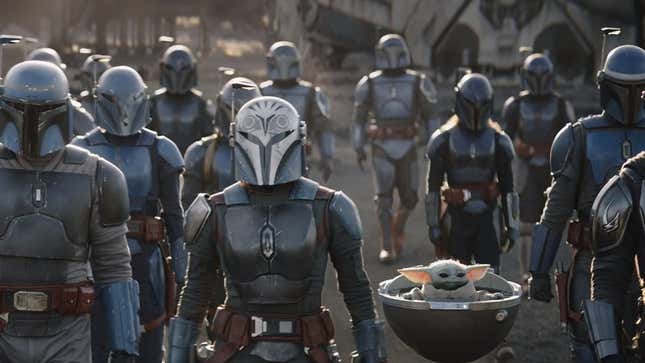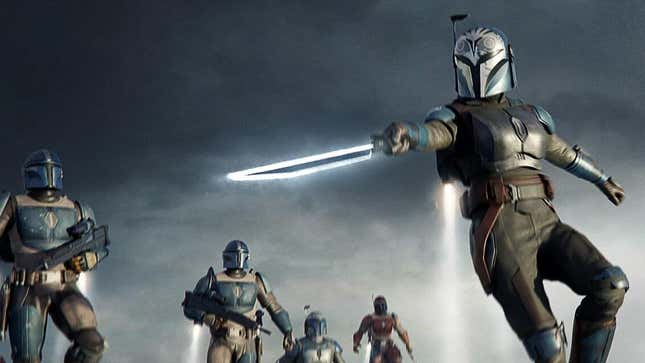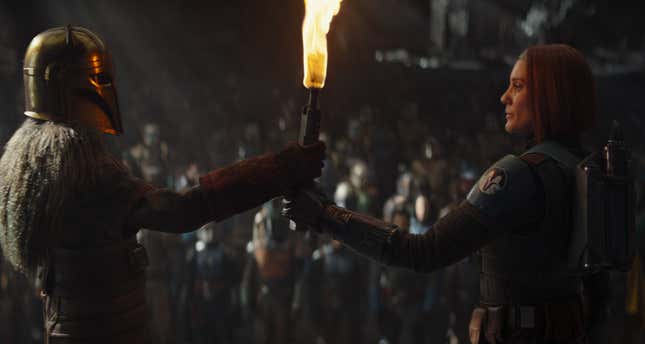Season three of The Mandalorian has finished telling its tale, and boy it’s been a bumpy ride. After the dizzying highs of Andor and the combined luggage of The Book of Boba Fett and Obi-Wan Kenobi, I clicked on the Disney+ app every week with an odd combine of pleasure and dread.
“That is it,” I’d assume. “That is the week issues go stomach up.”
And but, they didn’t! With a few exceptions (all the tales round Navarro had been type of an enormous snooze-fest; I must know what the stewards of these shows have in opposition to Luke Skywalker and the New Republic), the flagship Star Wars tv sequence saved up the power of the primary two seasons and delivered what I didn’t assume was attainable: a nuanced, mythic story concerning the restoration of Mandalore.
That story solely holds up due to two supporting characters: returning Clone Wars Jedi frenemy Bo-Katan Kryze, and blacksmith/priest/cult chief the Armorer, the latter of whom has carried the burden of explaining what Mandalorians “are” to informal Star Wars followers since season one. I’ve been stunned to see reactions to this season that derides these two characters. There’s been moaning about how the Armor is simply utilizing technicalities to resolve main conflicts, and complaints that Bo-Katan is being “accomplished soiled” or that her character arc is “embarrassing.”
However due to a mixture of nice performances, key camerawork, and a mythic presentation, these arguments couldn’t be farther from what the present is diving into: a meditation on how disparate teams of individuals reconcile their beliefs and work collectively to construct a brand new residence.

What Even Is a Mandalorian?
Mandalorians had been first launched in Star Wars within the movies The Empire Strikes Again and Return of the Jedi by means of the character of Boba Fett, a bounty hunter employed to trace down Han Solo and Princess Leia. Boba Fett’s fan-favorite standing inspired different Star Wars creators to dive into tales about Mandalore and Mandalorian tradition. Right here’s the factor although: if you happen to weren’t an enormous nerd within the ‘90s or 2000s, you knew none of that. Boba Fett was only a cool helmet man with a gun. The phrase “Mandalorian” wasn’t in your vocabulary. If nothing else the Disney+ present has moved mountains by making this obscure correct noun one thing that’s on the lips of on a regular basis Star Wars followers.
The Mandalorian moved these mountains by kicking off the primary live-action Star Wars TV present with a bunch of Mandalorians utterly unrelated to any worldbuilding that had been accomplished in The Clone Wars or another tales. To followers like me, this was baffling, and virtually felt like a retcon! But it surely gave recent viewers a straightforward solution to be taught what the phrase “Mandalorian” meant although protagonist Din Djarin and the Armorer. The Armorer is a non secular determine who dictates “The Creed” which guides this group of reclusive warriors, and Din Djarin visibly struggles to stay by its guidelines as he takes up a quest to guard Grogu.
It’s fairly spectacular worldbuilding, particularly when season two took the shock twist of re-integrating characters and ideas launched in The Clone Wars. Katee Sackhoff’s return as Bo-Katan Kryze allowed the actor to complete a narrative that started within the animated present and set her up as a contrasting determine to the Armorer. She desires to guide the Mandalorian people who find themselves now a scattered diaspora, and thinks {that a} relic referred to as the Darksaber may help her do it. She’s a secular character who desires to utilize a non secular image and brazenly scoffs on the practices of Din Djarin’s cult. That hostility is returned in form by the Armorer in an episode of The E book of Boba Fett during which she refers to her as “a cautionary story,” and at last explains the occasions that cut up the Mandalorian individuals aside: a genocidal purge performed by Giancarlo Esposito’s Moff Gideon.
Although Bo-Katan is later blessed because the Mandalorian who “walks each worlds,” it’s the actions of Din Djarin that reconcile these two perception programs. Din’s selfless curiosity in defending Grogu leads him on a journey the place he has to steadiness his adherence to the Creed and doing what it takes to defeat a fascist Imperial remnant. By the tip of season two, Din Djarin has by some means accomplished the not possible: he’s betrayed the Creed by eradicating his helmet, and but now wields the Darksaber, which ought to make him the chief of all Mandalorians.
Din’s private story fades into the background of The Mandalorian’s third season, however his simultaneous heresy and anointment units up an uncommon established order. The battle to reclaim Mandalore isn’t nearly energy, victory, or defeat, it’s now one which’s spiritual in nature.

Mandalore’s Reclamation and Echoes of Jewish Tradition
There’s no direct symbology linking Mandalorians to any particular Earth tradition, however as somebody raised in a (very secular) Jewish family, the entire thing appeared actually acquainted. The Mandalorians are a scattered individuals forged out of their homeland by a large Empire, and are actually divided into completely different tribes who start to tackle completely different cultures. That’s a succinct abstract of what I used to be taught concerning the tradition I grew up in.
That studying may even have some textual backing. Savvy Redditors noticed that an episode of season three referred to as “The Spies” contained a definite lack of any spycraft. However “The Spies” is perhaps a playful reference to the Twelve Spies from the Previous Testomony’s E book of Numbers. In that textual content, the Twelve Spies are a bunch of Israelite chieftains despatched out to scout the land of Canaan as a brand new residence for his or her individuals. And on this episode, 12 Mandalorians step as much as volunteer for a search get together that units out to reclaim Mandalore, which is a literal promised land for the Mandalorian individuals. (The whole get together that steps foot on the planet is 14 whenever you rely Bo-Katan and Grogu.)
That’s essentially the most literal Biblical reference I’ve seen in The Mandalorian however the place there aren’t references, there’s a very actual dramatic drive that feels true to how I used to be raised as a Jewish baby: Jewish individuals are continuously arguing about custom and adapting these traditions to slot in a altering world. For instance, a beloved textual content in my household was Joseph Stein’s Broadway musical Fiddler on the Roof, which tells the story of a Jewish household in Russia grappling with custom and violent change.
It’s a play the place this sort of battle is put entrance and middle. And due to Bo-Katan and the Armorer, so does The Mandalorian. Should you consider battle solely as a run-up to violence, then season three of The Mandalorian ought to pit these two leaders immediately in opposition to one another. Each Bo-Katan and the Armorer, unyielding of their beliefs, ought to battle over tips on how to reclaim Mandalore as suits their imaginative and prescient for the Mandalorian individuals.
However for these two, their battle turns into a method for reconciling the hole between their tradition, largely due to space himbo Din Djarin. His blundering again onto the floor of Mandalore units up a startling realization for each of his allies: the planet may be reclaimed, and it’ll take all the Mandalorian individuals to do it. These characters come to that realization in numerous moments. For Bo-Katan, it appears like this turns into attainable when she learns the planet’s floor isn’t a poisonous wasteland. For the Armorer, it’s when she hears that Bo-Katan witnessed a Mythosaur—a legendary creature whose return will “herald the start of a brand new period.”
Bo-Katan’s encounter with a Mythosaur within the Sacred Waters (which Din Djarin is unconscious for) is that this second that’s the fuzzy line between the religious and the literal. The Mythosaur itself doesn’t appear to be a supernatural creature, only a cavern-dweller that’s averted civilization. And there’s the rub of so many non secular traditions. Spiritual students are sometimes in a position to decide that with context, seemingly superstitious guidelines or occasions could make extra literal sense when you be taught extra about historic context. Religion can typically be a type of projection, and texts that had been interpreted a technique can now be understood in one other.
And if Mythosaurs weren’t seen by Mandalorians due to how giant and industrial the world had change into… seeing one would actually herald the daybreak of a brand new age. Diving right into a subterranean lake and catching a glimpse of your individuals’s equal of the Loch Ness Monster (then claiming it’s a spiritually related occasion) positive looks like a legendary “technicality.” But it surely’s a revealing occasion as a result of it highlights what number of of the Armorer’s tightly held traditions may simply be technicalities themselves.
The Mandalorian’s “Technicalities” Aren’t Technicalities, They’re Reconciliation

Arguments about the Creed in The Mandalorian date all the best way again by means of earlier seasons. Din Djarin is commonly challenged due to his standing as a “foundling” (an orphan adopted into Mandalorian tradition). His dotage of Grogu is off-putting due to how Mandalorians view Jedi as their mortal enemies. And the Armorer’s cohort Paz Vizsla calls for to know why Din is allowed to maintain the Darksaber though he’s “Mandalorian no extra.”
The Armorer is the one who weaves all these moments collectively. At occasions she is ready to interpret Din Djarin’s actions by means of the context of the Creed, and different occasions she attracts harsh traces. Regardless that Bo-Katan and fellow Mandalorian resistance fighter Axe Woves name her a zealot, she appears very removed from that. She’s a non secular chief attempting to reconcile teachings which might be imagined to have all of the solutions however aren’t absolutely sufficient to elucidate the horrible occasions which have befallen her individuals. Likewise, Bo-Katan isn’t a would-be warlord who’d do something for the Darksaber. In season three’s second episode, “The Mines of Mandalore,” there are some fairly deliberate photographs displaying how the blade falls from Din Djarin’s arms and is reclaimed by Bo-Katan. She eyes him fastidiously when he reclaims the blade after waking up—however doesn’t attempt to take it.
The enhancing on this scene is deliberate. Episode director Rachel Morrison appears intent on ensuring the viewer tracks who has “earned” the correct to wield the blade—as a way to sign to the viewers that Bo-Katan is rethinking tips on how to assist her individuals. It’s an amazing setup for when Din Djarin arms over the blade in episode six, “Weapons for Rent.” I perceive why individuals name this a technicality, nevertheless it actually may promote one thing extra resonant than the burden of a would-be Excalibur: that each one traditions are constructed on technicalities, and it’s the values of the individuals who consider in them that provides them life. Moff Gideon and different cynical warmongers embraced the custom of the Darksaber as a result of they valued energy. However by the point the third season of The Mandalorian got here to an in depth, Bo-Katan had rejected that mindset—and as a reward, was in a position to see Mandalore be really reborn.
It is a character arc that provides dimensionality to ascended background character Bo-Katan. She, the Armorer, and the viewers are all given time to replicate on the true which means of custom and to ask if battle wants to finish with a transparent winner, or if individuals who share elementary values can come collectively to do proper by their group.
All three seasons of The Mandalorian are actually streaming on Disney+.
Need extra io9 information? Take a look at when to count on the most recent Marvel, Star Wars, and Star Trek releases, what’s subsequent for the DC Universe on film and TV, and all the pieces you must learn about James Cameron’s Avatar: The Way of Water.
Trending Merchandise

Cooler Master MasterBox Q300L Micro-ATX Tower with Magnetic Design Dust Filter, Transparent Acrylic Side Panel…

ASUS TUF Gaming GT301 ZAKU II Edition ATX mid-Tower Compact case with Tempered Glass Side Panel, Honeycomb Front Panel…

ASUS TUF Gaming GT501 Mid-Tower Computer Case for up to EATX Motherboards with USB 3.0 Front Panel Cases GT501/GRY/WITH…

be quiet! Pure Base 500DX Black, Mid Tower ATX case, ARGB, 3 pre-installed Pure Wings 2, BGW37, tempered glass window

ASUS ROG Strix Helios GX601 White Edition RGB Mid-Tower Computer Case for ATX/EATX Motherboards with tempered glass…










